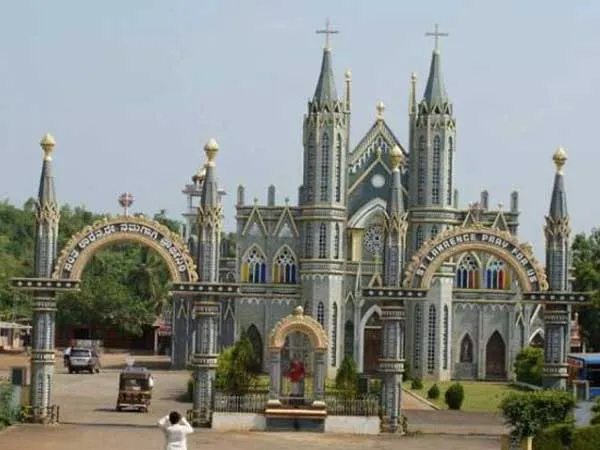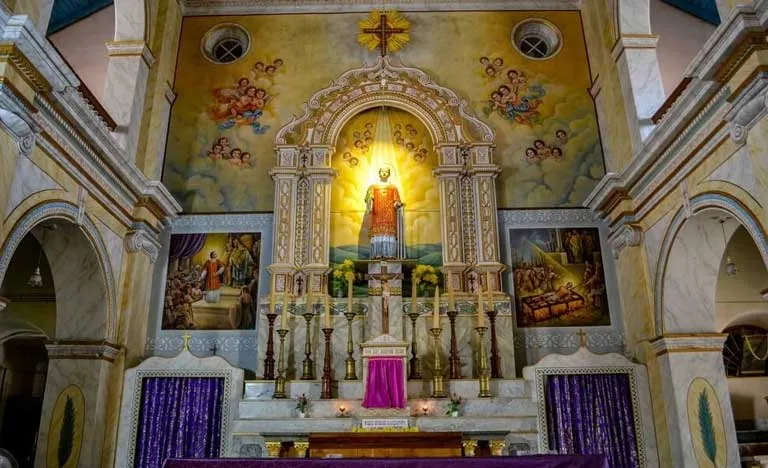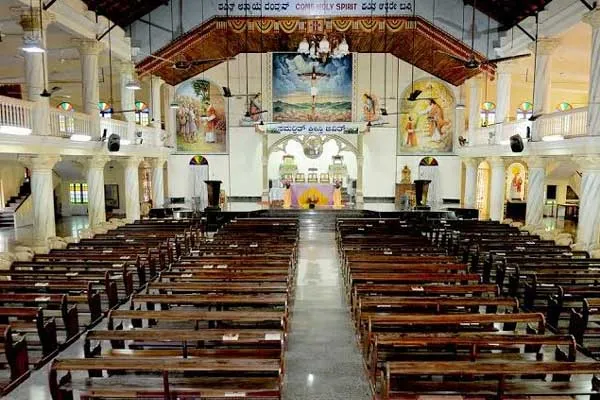
Introduction
Saint Lawrence Shrine Basilica, Attur, Karkala, Karnataka, India is known for his astonishing power of intercession with God. Over the past years the patronage of St. Lawrence over Attur has been remarkable. Rev. Fr. Frank Pereira’s successors too kept up the devotions and throughout the year people from near and far-off places were going to Attur on pilgrimage.
Not only the residents of Karkala and the pilgrims flocking there in great numbers, but also devotees who invoke St. Lawrence of Attur without visiting the shrine have experienced his powerful intercession. The number of pilgrims to the place throughout the year and specially those during the feast days in the month of January is an evident proof that St. Lawrence does not disappoint those who come to him in faith and devotion.
Saint Lawrence Shrine Basilica, Attur, Karkala in the diocese of Udupi is situated on the outskirts of Karkala town. Placed amidst placid greenery, the Attur parish and Shrine have a rich history with its origin tracing back to 1759. Moreover, it is known for its miraculous origin. Miracles, history, beauty, devotion, faith and social activities are all bound into one in this holy campus. Regional history tells us that the Christians of this place too were among those who underwent the captivity by Tipu Sultan.
Tipu, the king of Mysore, who ruled from December 29, 1780 to May 4, 1799 was a tyrant who forced Islam on other faiths, especially Christians. Or else, he held them captives as slaves, tortured and killed them. Those who had suffered the tyranny of Tipu Sultan and yet survived, returned to their respective places to build houses for themselves, their churches and their faith.
The parish church, in those days, was about 7 kilometers away from the present site. Tipu destroyed it and took the Christians as captives to Srirangapatna near Mysore. At the end of the captivity, the Christians who returned put up a small church building of thatched roof on the way to Nakre in 1801 under the leadership of a Goan priest.
History of Saint Lawrence Shrine Basilica, Attur
Saint Lawrence Shrine Basilica, Attur, deacon and Martyr of the Holy Catholic Church, is venerated by his devotees and pilgrims flocking to his Shrine at Attur-Karkala numbering over a million every year. He is even ‘worshipped’ as the ‘god’ of Karkala by many people. In the Tulu language, St Lawrence is affectionately addressed as ‘Karkalada Dever’ (god of Karkala).
The fame of the Shrine, which is spread far and wide, more for the miraculous powers of the Statue of St Lawrence, having its own history, has always been the centre of attraction, devotion and veneration. The history of this devotion is not a myth butbased on the facts of the life of this great but simple and humble Servant of God, who was privileged to live and die a martyr for his master Jesus Christ.
St Lawrence was one of the 7 deacons of ancient Rome, serving under Pope Sixtus II, martyred during the persecution by emperor Valerian in 258 AD. A deacon of that time was ordained to serve the poor. He was appointed both to the service of the table (corporal works of mercy) and to the service of the Word of God (spiritual works of mercy). St Lawrence is one of the most widely venerated saints of the Roman Catholic Church.
We learn that the Shrine of St. Lawrence at Attur – Karkala Parish seems to have been in existence even before 1759 A.D. History tells us that the Christians of this place too were among those who suffered captivity of Tippu Sultan from 1784-1799 A.D The parish church in those days was situated at a place about 7 kilometers away from the present church.
Tippu destroyed it and took the Christians to Shrirangapatna as captives. Those Christians who returned after freedom from captivity built a church with thatched roof on the way to Akre in the year 1801 A.D. under the leadership of a Goan Priest. In the year 1839 it was replaced by another building. It was about 4 Kilometers away from the previous one. This new building happened to be on the back of the present church and was facing west. A small flower garden is standing in that place now.
Soon it became a place for pilgrimage. Pilgrims from all sides came to this sacred place and innumerable were the favours granted by the Saint. In the year 1895 the parish priest, Rev. Fr. Frank Pereira finding so many devotees of St. Lawrence flocking to this Church and claiming to have received innumerable favours from the Saint fostered the devotion further and organized Novenas and prayer services making them more and more meaningful. Then in the year 1900 Rev. Fr. Frank built a Church facing the north. This Church was blessed and inaugurated on 22.1.1901 by the Vicar General, Very Rev. Mgr. Frachett.
For the next 150 years, Saint Lawrence Shrine Basilica, Attur remained a small shrine. However, as the number of pilgrims and believers grew, the need for expansion became evident. New constructions started in 1994. The semi-Gothic façade that you can see today was built and the entire church was restructured in 2001. What you see as the entrance to the church today is a fairly new addition. But a gorgeous one, nevertheless!
In August 2016, St. Lawrence Church was elevated to the status of a Minor Basilica, the 22nd in India.


St. Lawrence Church and It’s Miracles
Saint Lawrence Shrine Basilica, Attur, Karkala is believed to be the site of many miracles. Devotees flock to this place to get their fatal diseases cured, be blessed with babies, and find suitable jobs. They often burn huge candles, some towering up to 3-4 feet, in order to get the wishes fulfilled.
Recent Developments
Last 30 years the Shrines developments went on fast track as the flow of pilgrims has increased manifold. The little shrine of St. Lawrence that is adjacent to the sacristy was rebuilt by Rev. Fr. Frederick P.S. Moniz in the year 1975 wherein the miraculous statue is preserved. In the year 1993 Rev. Fr. Joswey Fernandes came here as Parish Priest. In the year 1994 he started the work of broadening the narrow space between the church and the hill on the eastern side of the Church. But during the monsoons a part of the hill slid and the cement sheet portico was destroyed. Also the ground on the eastern side of the Church was filled with the mud of the hill. With the aid received from the government and the help of the public this mud was cleared and used to broaden the school grounds. Now this school ground is not only used by school children but during January shrine Feast it is used for parking devotee’s vehicles.
A hundred feet high tower representing religious art of various regions was built in 1997, to symbolize the acceptance of people of various faiths. In July 1997 due to the heavy rains the hill slid again and the portico of Aluminum sheets was completely destroyed. Nothing happened to the new Tower, which indeed was said to be a miracle of Saint Lawrence. With the fallen mud of the hill, the deep ravine in front of the Church on the left side was filled up and the school grounds further extended. Because of these the right side of the Church became spacious. The people could now move about more conveniently and freely.
Architecture of St. Lawrence Shrine Basilica


The Facade
If you are an art or architecture lover or none, the facade of Karkala church will not cease to impress you. You will notice essential Gothic elements such as an evident focus on verticality, pointed arches, and huge stained glass windows. The whole ensemble is quite akin to a fairytale castle from Disney and makes for a worthy picture.
In this Shrine you will also see some of the most beautiful stained glass windows in India.
Statue of St. Lawrence
At the end of the shrine, right outside the rear door, you can also see the miraculous statue of St. Lawrence displayed in a glass case. Apparently, this is the same statue that firmly stood ground at Attur when devotees were looking for a new place to build the church in 1839.
Parpale Hills
The Cross at top of Parpale Hill is said to be erected around 1930-35, on top of the Parpale Hill belonging to St. Lawrence Church Attur. There is a road leading to this Cross and people can climb the distance of 1 k.m. behind the convent. The disabled can go on their vehicles.
On Palm Sunday after the Holy Mass and other usual Palm Sunday ceremony, sizable numbers of people take procession to the top of this hill to the western side of the church where the way of the Cross is conducted every year. There was a decree given by Most Rev. Bishop V.R. Fernandes dated 5.3.1934 by which the devotee praying before the Cross, one Our Father, one Hail Mary and one Glory be is granted 50 days indulgence.
The Twin Gates of the Church
Rev Fr Frank Pereira’s successors too kept up the devotions and throughout the year people from near and distant places were going to Attur on pilgrimage. St Lawrence of Attur is known for his special power of intercession with God. Over the past years the patronage of St Lawrence over Attur has been remarkable. Not only the residents of Karkala and the pilgrims flocking there in great numbers, but also devotees who invoke St Lawrence of Attur without visiting the shrine have experienced his powerful intercession. The number of pilgrims to the place throughout the year and specially those during the feast days in the month of January is an evident proof that St Lawrence does not dismay those who come to him in faith and devotion.
'Pushkarini' - Pond of Miracles
At the far end of the church there is a holy pond in the premises of the Shrine by the name ‘Pushkarini’. The pond is always full of water. The water is believed to have a miraculous healing effect and is said to have produced many healings. Devotees believe that the water of this pond heals the diseased. Hence, this pond is often referred to as the Miracle Pond.
Hence, most of the pilgrims make it a point to visit this pond.
Beautiful Stalls


Visiting time of stalls everyday is from 8am to 6pm.
Feast Day – Last Week of January
Attur Jatre: The Jatre or the Attur Festival is the annual religious and cultural festival of the church. It is held every year for 5 days between 21st and 28th January. It includes a traditional praying ceremony called the Novena followed by a feast.
Christians who returned to Attur from the captivity of Tipu Sultan found themselves homeless and landless because all their lands were occupied by people of other faiths. Hence they took to working in their fields as daily labourers earning daily wages in kind as rice. Since money was required for other purchase for sustenance, the men folk took up jobs far away in coffee estates. The devotion to St Lawrence grew day by day and since there was no possibility to communicate through the media, especially for the people who were far away from Attur-Karkala, it was agreed to celebrate the annual feast on Tuesday, Wednesday and Thursday of the last week in January so that devotees from far and near could confidently visit Attur to celebrate the annual feast. This tradition has been kept up faithfully by the Shrine every year.
The Church of St Lawrence at Attur-Karkala is synonymous with the Shrine so much so when one speaks of visiting the church of St Lawrence at Attur, it is meant also the Shrine and vice versa. The annual feast is known as a Jatre in the local language to mean, paying homage to the miraculous Statue in person, making a good confession, participating in the holy rituals of the liturgical celebrations, making the offerings and fulfilling their vows, especially of lighting the candles. It is believed that if a person visited the Shrine during the annual festival and lighted a candle making a wish, the wish would come true. The people from various faiths flock to the Shrine during the annual feast either to fulfil their vows or pay their respect to the much-revered St Lawrence and return only after receiving his ‘darshan’ (glimpse).
Mass Time
Weekdays
Thursdays
Saturdays
Sundays
- 7.30 am – Mass followed by Novena
- 10.15 am – Second Mass
Contact Info
Attur P.O., Karkala, Udupi District,
Karkala, Karnataka – 576 117, India.
Phone No.
Tel : +91 87620 33222 , 8258230322
Accommodations
Connectivity
St. Lawrence Shrine Basilica, Attur, Karkala, Karnataka, India is situated about 38 Kms. from Udipi, the district headquarters of Karkala Taluk and about 54 Kms from north east of Mangalore. There are direct bus services from most of the major cities of Udipi and South Kanara district. This shrine is well connected with Bus Station, Railway Station and Airport facilities rest of the country.
Airways
Mangaluru International Airport, Karnataka, which is (40.5 Kms) from St. Lawrence Shrine Basilica, Attur.
Railways
The nearest railway station is Udipi Railway Station which is (33.6 Kms) from St. Lawrence Shrine Basilica, Attur.
Roadways
The nearest is Karkala Udupi Bus Stand which is (5.3 Kms) from St. Lawrence Shrine Basilica, Attur.








